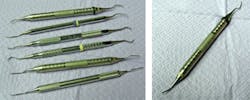You Don't Really Expect Me To Scale Teeth With That, Do You?
Why Does Metallurgy Matter With Our Instruments?
By VICKI L. MUNDAY, RDH
What do average dental hygienists know about metallurgy, and does it really matter to them? The answer is, not many hygienists know anything about metallurgy nor do they care.
In my search for instruments that not only do I love, but that also hold a blade for a very long time, I did some research and discovered that metallurgy is important and it does make a difference. I also discovered that many of my colleagues have unrealistic expectations for how long an instrument should last (see Figure 1). Taking into account variables for sharpening and usage, the correct answer is 24 months. Yes, that’s right. Think about it — the dentist reorders burs as they wear out, but somehow hygiene instruments are magical and last forever … not! Let’s be real about this. Your patients expect excellence, so give it to them by having instruments that are in sharp and well maintained.
Twenty years ago, I graduated from Shoreline Community College with my degree in dental hygiene. While in school my classmates and I learned to use various instruments. Being the one known for “thinking outside the box,” I had to go explore other types of instruments. I was introduced to my now-favorite instrument, the well known Montana Jack, by my good friend Susan Savage, who went to college in Indiana. This instrument was developed by Paradise Dental Technologies, or PDT as they are commonly known. I recently met the Queen of Hearts, also manufactured by PDT.
Have you ever gone to an office to temp for a colleague who is out for the day, only to discover the instruments you have to use are like using a cheese spreader when you need a steak knife? Or, they pull out “special instruments” for you (see Figure 2), set aside for temps? I can understand that we all are protective of our instruments and don’t want anyone else sharpening them. But seriously, think about not only the poor hygienist who is trying to do a good job with dead instruments, but the poor patient! It is because of these experiences and others that I now carry a small selection of my own instruments with me. I have chosen to take ownership of how I approach filling in for a colleague. I want to be remembered as the hygienist who took exceptional care of the patients entrusted to me. I encourage you to do the same.
While attending the Chicago Midwinter meeting this past February, I had the opportunity to meet with many hygienists and ask them what their favorite instruments are. It seems that depending on the area of the country where you attended college, the instruments you were introduced to can be very different. Unfortunately, it is common for hygienists to settle into the instruments they were taught to use in school and not stray outside of that comfort zone. With that being said, I would encourage all of my dental hygiene colleagues to move outside of your comfort zone and check out some new instruments. You might just find that there are some instruments out there that will help you be more efficient and more effective in your delivery of dental hygiene services. My education in Washington did not include exposure to Barnharts, McCalls, Langers, Rules, or Younger-Good curettes. I learned Columbia 13/14 and 4R/4L, Graceys, and anterior sickles. We also had files and learned alloy overhang removal with a gold knife.
There are some amazing instruments out there in the big wide instrument world. Many hygienists have shared their vision of an instrument with manufacturers and have helped in the design of some great instruments. Many great minds have spent years perfecting the designs to help us be more efficient in our delivery of dental hygiene therapies. Linda Miller, CEO of PDT, has perfected the metallurgy that makes their instruments superior to others on the market, in my opinion. The special heat treatment and cryogenic processes that they developed create a harder, stronger molecular grain in the metal. This means that these instruments are not only stronger, but they also hold a sharper edge longer, allowing the hygienist greater use of time and talents.
There is an old saying, time is money. Well, in hygiene we can take that a step further and say efficiency = time = money. The more efficient we are, the less time it takes, and the better our practices are with an increase in the quality of care we provide. Your value to your employer increases when you are proficient at maintaining your instruments and save on office overhead. All of this can be part of the conversation you have with your doctor when discussing the need for new instruments or increased compensation.
While attending state dental and dental hygiene conferences, I encourage you to visit all of the instrument company booths and “play” with any instrument you have not used before on a dentoform. Test the ergonomic feel of the instrument and the tactile feel on the dentoform teeth. Ask questions about metallurgy and hardness. Standards in metals used by instrument manufacturers vary greatly, and standards for instruments fabricated overseas are not as strict as those in the United States. My preference is 100% USA-made, because that assures me that quality standards have been used in the manufacturing and there is consistency from instrument to instrument. Just remember, the harder the blade, the longer it will hold an edge and the less sharpening you will need to do … so how that metal is handled in manufacturing is important.
I would also encourage you to use a sharpening guide. If you “freehand” sharpen your instruments, you will shorten their life and create an edge that is not optimally sharp, which ultimately leads to burnished calculus deposits and ineffective use of the instrument. Either way, you are not giving your patient the best care you can if your instruments are not the best they can be. Well-made instruments that are well maintained — combined with your good clinical skills — are the key to effective instrumentation and superior patient care.
So what alternative do we have other than to “freehand” sharpen instruments? Instrument-sharpening guides are available, and one of my favorites is the Gleason Guide from PDT. The Gleason Guide was developed by a master knife-maker, for whom the guide is named. This invaluable tool assures the instrument is positioned properly so that the edge angle is maintained, thus lengthening the life of the instrument and providing the sharpest edge possible for greater efficiency. We practice in a profession where the patient may love us but be anxious about the treatment we perform. If we can make that experience easier and less traumatic, we will have happier patients. Sharper, better ergonomic instruments make our job easier, and the result is happier patients.
Go explore, get outside your comfort zone, and try some new instruments. You might just find some new go-to instruments. I know I have. My patients appreciate my use of new and innovative instruments to help them maintain their oral health. They actually look forward to coming in to see what I have to show them. Be the hygienist your patients ask to see. RDH
VICKI L. MUNDAY, RDH, is a 1992 graduate of Shoreline Community College. She is very involved in the American Dental Hygienists’ Association and the Washington State Dental Hygienists’ Association (WSDHA), where she has been chair of the political action committee for the last eight years and served as president in 2000. She is currently president of LVS2SMILE Dental Hygiene Services, where she represents several dental products under her business license.
Past RDH Issues


